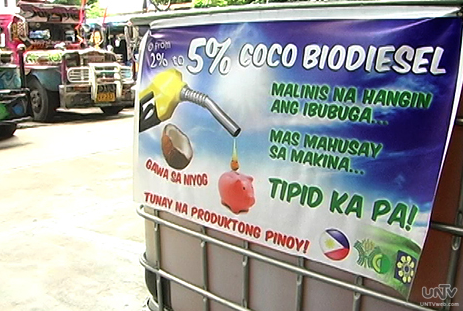The government should take advantage of the lower price of nature-friendly biodiesel by raising coconut methyl ester’s (CME) mix to diesel to 5% so as to generate huge foreign exchange savings equivalent to P23.4 billion yearly.
Aside from enhancing the fuels’ ability to cut pollutant greenhouse gas emission, the increase in the biofuel will enable Philippines to displace a big amount of imported diesel, according to United Coconut Association of the Philippines (UCAP) Chairman Dean Lao Jr.
“We are importing 13 billion liters of diesel (yearly). From B2 (2% biodiesel) to B5 (5% biodiesel), we can displace an additional 390 million liters equivalent to P23.4 billion,” Lao told a press briefing hosted by the Philippine Chamber of Agriculture and Food Inc. (PCAFI).
The Philippines was a pioneer in 2006 in adopting the biodiesel technology through CME, being itself then the biggest exporter of coconut oil.
Having ratified Republic Act 9367 or the Biofuels Act of 2006, government subsequently implemented biodiesel mix of 2%. Despite its early adoption, the Philippines has been overtaken by other Southeast Asian countries in maximizing use of the environment-friendly technology.
“When we started in 2006, we were the pioneer. Now, we’re the laggard,” said Lao.
Indonesia is now the leader in biodiesel with its mix reaching to 30% and even announced early this year a 35% blend.
The country’s commercialization of biodiesel has stagnated since 2009, the last time that the biodiesel mix was raised from 1% to 2%.
Along with the cheaper price now of biodiesel compared to fossil fuel-based diesel, the Philippines is missing on the other advantages of a higher biodiesel mix. These are improved vehicle mileage and the reduced pollutant carbon dioxide emission to the environment.
Due to the slow uptake on the technology, several companies are not operating at present, incurring opportunity loss.
The Philippines, in fact, has excess production of CME.
“Do we have enough coconut? There is enough coconut oil to supply biodiesel. The infrastructure is ready to supply an increase from 2% to 5%. The capacity is ready. And It’s the simplest to implement,” said Lao.
PCAFI, led by its president Danilo V. Fausto, recommended the increase of CME blend to B3 by January 2024; B4 after six months thereafter; then B5 by 2025.
“The National Biofuels Board (NBB) has not championed B5 despite its merits. Misinformed politicians’ campaign against biofuels,” according to PCAFI in a position paper.
Pollutant emission from 100% biodiesel has been proven to be 74% lower than those from petroleum diesel, according to a life cycle analysis conducted by the Argonne National Laboratory.
As it uses generally vegetable oils compared to the depleting petroleum resource, biodiesel is deemed a renewable and biodegradable fuel.
“Biodiesel meets both the biomass-based diesel and overall advanced biofuel requirement of the Renewable Fuel Standard,” reported the Department of Energy (DOE).
DOE cites other benefits of biodiesel including clean burning and use of domestic production.
“Using biodiesel as a vehicle fuel increases energy security, improves air quality and the environment, and provides safety benefits,” according to DOE. “Biodiesel in its pure, unblended form causes far less damage than petroleum diesel if spilled or released to the environment. It is safer than petroleum diesel because it is less combustible.”
Vehicle engine operation is improved as biodiesel improves fuel lubricity and “raises the cetane number of the fuel.” (PR)
Photo credit: UNTV

